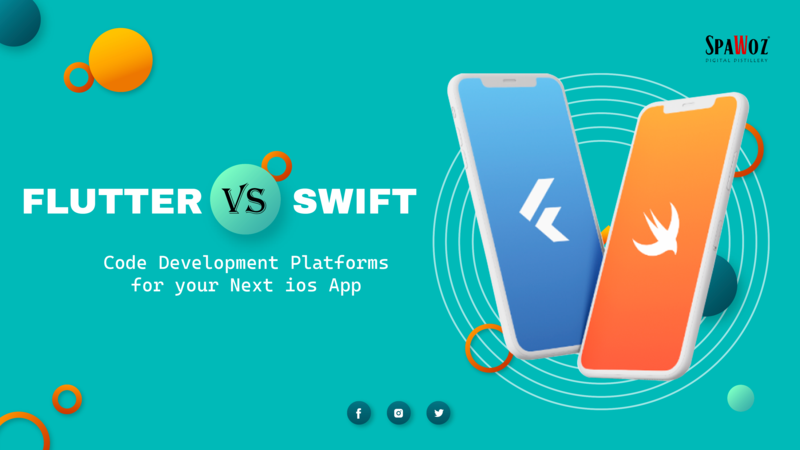
Selecting the Appropriate Framework for iOS App Development: A Comparison of Flutter and Swift
Intoduction
Mobile app development is rapidly evolving, and it is essential for developers to stay updated on the latest tools and technologies to build high-quality apps efficiently. When it comes to iOS app development, there are several frameworks available, each with its advantages and disadvantages. Two popular frameworks that developers often consider are Flutter and Swift. In this blog post, we will compare these two frameworks to help developers understand the differences between them and select the appropriate one for their iOS app development project.
What is Flutter?
Flutter is a mobile app development framework created by Google. It is an open-source framework that uses the Dart programming language. Flutter is designed to build high-performance, natively compiled apps for mobile, web, and desktop from a single codebase. Flutter provides a rich set of pre-built widgets, making it easy for developers to create beautiful and responsive UIs for their apps. With Flutter, developers can build apps for both Android and iOS platforms using a single codebase, which saves time and resources.
What is Swift?
Swift is a programming language developed by Apple. It is a powerful and intuitive language designed to be easy to learn and use. Swift is used to develop apps for Apple's platforms, including iOS, macOS, watchOS, and tvOS. Swift is a statically typed language that is designed to be fast and efficient. It provides features like optionals, type inference, and generics, making it easy to write safe and concise code. Swift is the recommended language for iOS app development by Apple.
Comparison of Flutter and Swift:
1. Language
Flutter uses the Dart programming language, while Swift uses the Swift programming language. Dart is a newer language that was created by Google, while Swift was created by Apple specifically for iOS app development. Both languages have their advantages and disadvantages. Dart is a more modern language with features like async/await, making it easier to write asynchronous code. It also has a just-in-time (JIT) compiler, which enables developers to quickly test and iterate their code. However, Dart has a smaller community and fewer resources available compared to Swift.
Swift is a more mature language with a larger community and more resources available. It has a strong focus on safety, making it less prone to errors and crashes. Swift also has a faster performance compared to Dart.
2. Development Environment
Flutter can be used with any text editor or integrated development environment (IDE), such as Visual Studio Code, Android Studio, or IntelliJ IDEA. Flutter has a built-in hot reload feature that allows developers to see the changes they make to the code in real-time. This makes development faster and more efficient.
Swift, on the other hand, requires Xcode, Apple's integrated development environment. Xcode is a powerful tool that provides everything developers need to build and deploy iOS apps. However, Xcode can be challenging to learn and use, especially for new developers.
3. User Interface
Flutter provides a rich set of pre-built widgets, making it easy for developers to create beautiful and responsive UIs for their apps. Flutter widgets are customizable, and developers can create their own widgets if needed. Flutter also provides a feature called "Flutter for web," which allows developers to build web apps using the same codebase they used for their mobile app.
Swift provides a UI framework called UIKit, which is used to build the user interface of iOS apps. UIKit provides a wide range of pre-built components, such as labels, buttons, text fields, and more. Developers can customize these components to match the design of their app. However, UIKit is specific to iOS and cannot be used to build apps for other platforms.
4. Performance
If you're looking for a cost-efficient framework with cross-platform functionality, Flutter is a great option for building iOS applications. Its layered architecture reduces the overhead of platform-specific APIs, resulting in improved performance and smooth animations and transitions. Flutter also uses a Dart garbage collector, which is Ahead of Time (AoT) compiled and allows for quick communication with the device. With the Flutter animation package, building sleek and intuitive UIs is made easy, and the pre-set effects can be customized to fit your needs. In short, if you don't need the most from your iOS application, Flutter performs just as well as Swift.
On the other hand, if budget isn't a constraint and you're willing to develop separate applications for each platform, Swift is the optimal solution. As a native framework, Swift provides superior efficiency and helps deliver fast, smooth, and reliable applications. It generates highly optimized code and offers a rich set of system APIs that can improve application performance. Additionally, Swift's automatic reference counting feature ensures effective memory utilization, making it a great option for applications that require significant computational power.
To Sum up,
Both Flutter and Swift are great options for mobile app development, and choosing one over the other depends on your individual needs and preferences. Flutter provides advantages such as cross-platform development, faster development with hot reload, and a wide range of rich widgets. On the other hand, Swift offers native performance, a robust type system, and powerful development tools like Xcode. Ultimately, your decision should be based on your priorities and the requirements of your app. If you need assistance, you can consult with a reputable Flutter app development company to help you make an informed decision and move forward with your Flutter development according to your needs and requirements.
